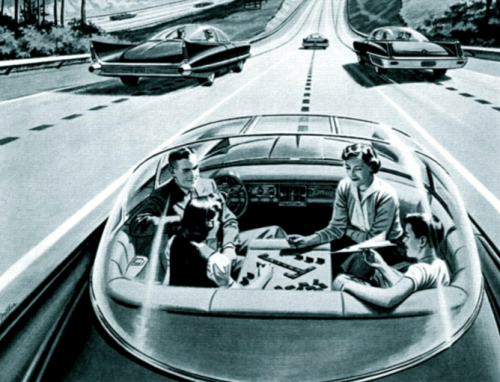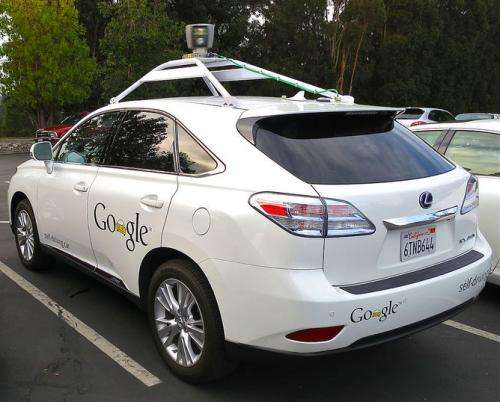Driverless public transport will change our approach to city planning – and living

Just a couple of years ago, driverless cars were viewed as little more than a geekish techno-fantasy. But the entry of tech behemoth Google has produced an autonomous car that is now very close to entering the market.
Test-running on streets in the US has been underway for some time and they will be street legal in the UK from the start of 2015. To start this process rolling, a series of small-scale UK city trials has been recently announced.
Greenwich in London will have an autonomous tourist passenger shuttle, and autonomous valet parking for specially adapted cars. Milton Keynes and Coventry will host the UK Autodrive programme, and the Venturer consortium in Bristol will examine the effects of autonomous cars on congestion and road-traffic safety.
In Milton Keynes, small electric autonomous pods known as LUTZ Pathfinder will start running in the spring. Like an autonomous two-seater taxi, they will provide short-distance links between the station and destinations in the city centre running on cycleways and footpaths, mixing with pedestrians and cyclists. The project links to the wider Milton Keynes Future Cities Programme and Open University-led MK:Smart project.
MK:Smart, jointly funded between 12 partners and the Higher Education Funding Council for England, is exploring the use of big data systems to develop innovative ways of managing water, energy and transport. Part of MK:Smart is to adopt a strategic view on where data-driven innovations might be plugged into the local economy, helping people and the city's development as a whole.
Tearing up the transport map

Adopting autonomous vehicles could have a big impact on the way transport is designed and planned for in towns and cities. The project in Bristol is right to be examining how this will play out regarding safety and sustainability, but I would argue that the effects of driverless vehicles on transport planning will be fundamental.
If a city has system of autonomous vehicles booked using apps taking people door-to-door, 24-hours a day, where does that leave taxis and minicabs? With no driver the running costs would be low, pushing fares down towards those of a bus. If the mere use of the Uber app is causing mass protests and legal challenges, wait until a technology arrives that could out-compete taxis alltogether!
Equally, where does this leave mass transit like buses, tram or metro? The system architecture of bus service: large vehicles, operating to a timetable on fixed-corridor routes where passengers can board from specified stops – hasn't changed since the days when they were pulled by horses.
Autonomous cabs on the other hand have an entirely different system architecture. The vehicles are small, and the destination is set by the passenger, rather than tied to specific routes. It's a totally different sort of public-transport design. Battery-electric pods wait for customers at local ranks (recharging there) and when one pod is called to an address, another automatically replaces it to await the next customer.
Some small-scale tests are already underway – for example autonomous pods run on segregated tracks operate between Heathrow Terminal 5 and its car park stations. But because rapid progress in computer routines is allowing the vehicles to operate in ordinary traffic, there is potential for a more integrated approach and one that can provide a viable alternative to the private car in suburban areas. In terms of sustainability and cutting pollutants in cities, this system-level impact is possibly the most important aspect.
Discover the latest in science, tech, and space with over 100,000 subscribers who rely on Phys.org for daily insights. Sign up for our free newsletter and get updates on breakthroughs, innovations, and research that matter—daily or weekly.
Transport designed for passengers
Transport policy has tended to view the present model of public transport as fixed for eternity and remains ingrained in the approach taken towards improving public transport for the future. This means requiring people to arrange their lives around the service design of a transport system, rather than designing the transport system to suit people's needs.
This difference in system design is the potentially transformative impact of autonomous public transport using small vehicles – passengers can travel directly, whenever they want, 24/7, to exactly where they want to be – including to many places and at times existing public transport services cannot provide.
Realising the possibility of this fundamental change could turn transport and urban planning on its head. Autonomous vehicles are likely to be used very differently from the vehicles of today – replacing existing transport businesses and creating new ones. It is a design that could yield substantial environmental and social benefits. But the gritty details and inevitable politics have only just begun – and there is everything to play for in shaping our transport of the future.
Source: The Conversation
This story is published courtesy of The Conversation (under Creative Commons-Attribution/No derivatives).
![]()





















